Page Updated:
Prominent, protruding ears can have a significant impact on self-esteem. Children with abnormally protruding ears may face psychological pain due to feeling different or being teased. Adults with prominent ears may feel self-conscious and go to lengths to camouflage them. Otoplasty, also referred to as ear pinning or ear shaping surgery, is a procedure to reposition and recontour prominent ears. San Diego Otoplasty Specialist Dr. John Hilinski is a Board-Certified Plastic Surgeon who is highly knowledgeable in ear shaping techniques. He is experienced in performing complex ear surgery for children and adults, and he is known for personalized care and natural-looking results.
Otoplasty is intended to reposition the ear and it is a solution for people who feel that their ears stick out too far. As a Facial Plastic and Reconstructive Surgeon specializing in ear surgery, Dr. Hilinski also offers other ear procedures, including preservation otoplasty, earlobe reshaping, gauge earlobe repair, and ear reduction surgery (macrotia) for patients who wish to reduce the overall size of their ears. Experts agree that ear correction requires a high level of surgical expertise and, when performed successfully, it can improve self-confidence and offer significant aesthetic and psychological relief.1
- About Otoplasty
- Planning Your Otoplasty Procedure
- Macrotia Surgery to Reduce Ear Size
- Terms and Anatomical Landmarks in Otoplasty
- Appearance of the Overly Prominent Ear
- Otoplasty Candidates
- The Otoplasty Procedure
- Immediate Appearance Following Otoplasty
- Visibility of Scars
- Recovery from Otoplasty
- Otoplasty Results
- FAQs About Otoplasty
About Otoplasty
Otoplasty is used to reposition the ears back into a natural position and/or improve the appearance of congenital ear deformity, such as lop ear or cup ear. The ears are commonly made to appear smaller and/or less prominent. There is very little discomfort and most patients can resume a fairly normal schedule within a week. With children it is best to undergo the procedure around five years of age or older. At this age, the ear has achieved at least 90% of its adult size and children seem more compliant with the treatment. More importantly, the intervention is early enough to prevent the damaging effects of remarks that often come once schooling begins.
“I had an otoplasty procedure done and I am extremely satisfied with the results. Dr. Hilinski and his staff were always very polite and professional. They made sure to explain everything quite thoroughly to ensure I knew exactly what to expect. I would recommend Dr. Hilinski if you are considering getting this procedure done.”
Planning Your Otoplasty Procedure*

Average Cost: $8,000
Average Procedure Time: 2.5 hours
Average Recovery Time: 10 days
Post-Op Consultation: 2 months
*Procedure pricing and results with Dr. Hilinski may vary. Your personalized treatment plan and pricing will be determined at your consultation appointment.
Macrotia Surgery to Reduce Ear Size
Macrotia ear surgery is a cosmetic procedure to reshape and reduce the size of the ears. While ear pinning patients seek out otoplasty to correct ears that stick out too far from the head, but are not actually oversized, macrotia surgery patients have ears that are excessively large in size or out of proportion with the rest of their head. Dr. Hilinski is highly experienced in macrotia surgery to help patients in San Diego improve their ear shape and reduce their ear size.
Terms and Anatomical Landmarks in Otoplasty
Simply put, most patients seek otoplasty because of overly prominent ears. In fact, the most common complaint our facial plastic surgeon, Dr. John Hilinski, hears from potential otoplasty patients is that their ears stick out too far from their head.
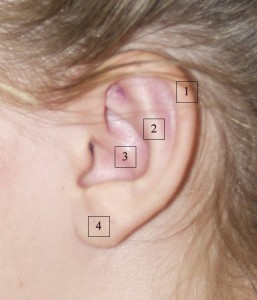
In order to understand the actual deformity that contributes to an overly prominent ear, one must first have basic knowledge of the relevant terms and anatomical landmarks used when discussing otoplasty. The adjacent photo is provided to help guide your learning and is an actual post-operative photograph of one of Dr. Hilinski’s patients. The term auricle refers to the external structure of the ear that is attached to the side of the head. In the adjacent photo, everything you see comprises the auricle.
The helical rim, or helix, (1) corresponds to the outer border of the ear and should ideally be a smooth, continuous curvature that goes nearly 270 degrees around the auricle. The helix is composed of a thin rim of cartilage with tightly wrapped skin overlying the cartilage.
The helix serves a critical role in providing a skeletal scaffolding for the auricle. Without a well-formed helix, the ear would literally flop down off the side of the head. Fortunately, in most cases of otoplasty the helix does not need to be directly reshaped or altered. It will move passively when adjacent structures are reshaped, but there is little direct manipulation of the helix in most otoplasty patients.
The antihelix (2) refers to a natural ridge that is situated inside of the helix. As the antihelix goes upward, it divides into a Y-shaped structure as seen in the photo. The antihelix exists because the underlying cartilage folds upon itself during normal development. In doing so, the antihelix naturally pulls the upper portion of the ear close to the head. It is normal to see this ridging of the cartilage as it courses through this segment of the ear. In fact, it is precisely when the antihelix is poorly formed or even absent that the ear looks abnormal (see discussion and photos below). Because the fold does not exist, the cartilage spreads out flat across a wider surface area, thus making the ear stick out farther than average. Accurate assessment of the antihelix is a critical step in evaluating candidates for otoplasty as this has to be commonly addressed to achieve optimal results.
The antihelix forms the back border of what is called the conchal bowl, or concha (3). This is the portion of the auricle that resembles an actual bowl. In many otoplasty patients, the conchal bowl is overly developed and excessively large for the ear. It is usually more of an issue the bowl is excessively deep rather than being too wide. The end result of having such a deep bowl is the entire ear gets pushed out farther away from the side of the head, which contributes to an overly prominent ear.
The lobule (4) is the fleshy portion of the auricle where most females get their ears pierced. What is unique about this structure is that, unlike other areas of the auricle, there is no cartilage underlying the skin of the lobule. The lobule is, unfortunately, often times overlooked during an otoplasty. In many cases the lobule protrudes outward much like the cartilage does in the overly prominent ear. However, since the lobule does not contain any cartilage, specific maneuvers have to be performed separate from the cartilage contouring in order to bring it closer to the head.
Now that we have a foundational understanding of the terms and anatomical landmarks of the ear, let’s use this knowledge in evaluating the overly prominent ear.
Appearance of the Overly Prominent Ear
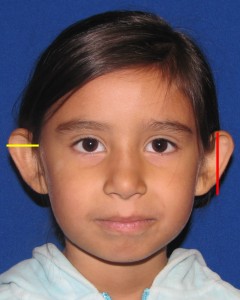
The adjacent photos help to visually demonstrate what the overly prominent ear looks like. In order to gain a complete understanding of what needs to be addressed during the otoplasty procedure, several different views are necessary. These include the frontal, side (or lateral) and base views.
As seen in the adjacent frontal photo, this young girl has overly prominent ears. The yellow line indicates how far the ear sticks out from the head. This is on average 18-25 millimeters as measured from the surface of the scalp just behind the ear to the helical rim. In this particular patient, this measurement is closer to 35 millimeters.
The red line indicates the vertical height of the ear, which is normally around 60 millimeters from top to bottom. Fortunately, it is actually somewhat unusual to see otoplasty patients whose ears are significantly larger than average in this particular dimension. Therefore, Dr. Hilinski rarely has to make adjustments in this particular measurement when performing otoplasty.
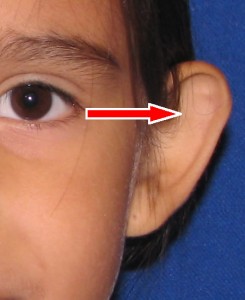
On close-up of this patient’s left ear, you can better appreciate how her antihelix is poorly developed (red arrow). When looking at this region of the ear it looks quite flat, as if something were missing. Indeed, the natural antihelical ridge is missing. What many otoplasty patients do not realize is that it is normal to see undulations and ridging of the ear. It is when these undulations and ridges are missing that the eye is naturally drawn to this area. By virtue of not having this natural fold in the cartilage, the ear then sticks out further to the side of the head.
One of the goals of otoplasty, or ear reshaping, in this type of patient would be to create the natural antihelical fold, which would essentially bend the ear back closer to the head. This is accomplished by placing permanent sutures from behind the ear to bend the cartilage structure to the desired shape. In this particular case, she would also need to have the conchal bowl reduced in size thus further bringing the ear closer to the side of the head.
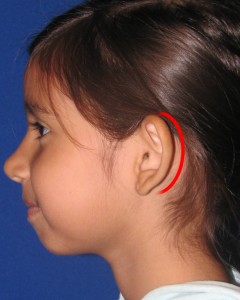
On lateral view of the ear, one can see that the auricle appears to stick out directly toward you. Although lateral photos do not demonstrate the true three-dimensionality of the prominent ear, you can still appreciate the fact the ear is abnormally positioned. When you look closer, as seen in the adjacent photo, you cannot even see all of the normal structures of the ear. The reason is because the auricle is angulated away from the surface of the head, thus limiting visualization of the normal anatomical landmarks. By comparison, take another look at the appearance of a normal ear as seen above in our discussion. You should now be able to easily appreciate the differences between a normal and abnormal lateral view.
In this particular patient example, you cannot even see where the antihelix would be due to the severe lateralization of her ear. The ear should actually be positioned more posteriorly, or toward the back of the head. In the adjacent photo, the red curved line indicates more where the helical rim, or outside border of the auricle, should be positioned.
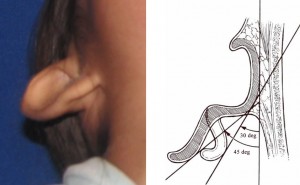
On base view of the average otoplasty candidate, you can also see how the auricle literally sticks out off of the side of the head.
As is seen in the adjacent diagram, the normal angulation off the side of the head is around 30 degrees, give or take. In the typical otoplasty candidate, this angulation is opened up to about 45 degrees and in many cases much more. This change in angulation translates into a significantly more lateralized ear that appears much more prominent. This base view can be particularly telling when it comes to assessing the overly prominent ear.
Otoplasty Candidates
Otoplasty can be performed once the ears are fully developed, which can vary but typically occurs around the age of five.2 At that point in our development, the ear is relatively well formed. In fact, the ear typically does not grow any further after this age. This is also around the time that young boys and girls are beginning to go to school. With prominent or overly large ears, these patients can potentially be the target of ridicule from other kids. From a social perspective, timing of otoplasty around this age is considered nearly ideal if it can help avoid this type of unwanted social pressure. That being said, a significant number of Dr. Hilinski’s otoplasty patients are older. Many patients, for one reason or another, simply do not have their surgery performed early on in life. Instead, they present as young adults, middle-aged and even elderly patients seeking otoplasty.
The Otoplasty Procedure
Otoplasty is typically performed on an outpatient basis in our fully accredited AAAASF certified ambulatory plastic and reconstructive surgery center at The Hilinski Clinic. In younger patients (usually 5-15 years old), otoplasty is typically done under a general anesthetic or IV sedation. In older patients, otoplasty can be done under local anesthesia (like going to the dentist) with or without oral sedation (with something like Ambien or Valium). The ears are injected with a novacaine-like solution that provides a complete numbing sensation.
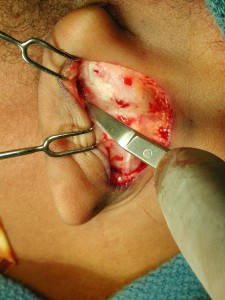
The otoplasty technique that Dr. Hilinski uses involves incisions made entirely behind the ear in 99% of the cases (see adjacent intraoperative photo of the standard otoplasty approach in our office). This minimizes any chance of visible scars when looking at the ears from the front and side. Even when looking at the ears from behind, it is quite difficult to see the scars.
The ear shaping is accomplished through the incision on the back of the ear. This includes creation of the antihelix, reduction and repositioning of the conchal bowl, and reshaping of the lobule of the ear as necessary. For the most part, these maneuvers are done with use of permanent sutures that hold the ear in its new position and shape. When reducing the conchal bowl prominence, there is typically some degree of cartilage removal but only as necessary to accomplish the desired goal. Once the ear reshaping has been completed, the incision is closed behind the ear with absorbable sutures. In this manner, there are no sutures that need to be removed in the postoperative period.
Immediate Appearance Following Otoplasty
Cosmetic ear reshaping patients are always curious about what they will look like immediately after this type of plastic surgery. To answer this question, we have provided the following photos that show what the average otoplasty patient experiences. These photos show a female patient who underwent ear pinning for overly prominent ears using the techniques discussed above. The photos show her appearance within minutes of successfully completing the otoplasty surgery, just prior to applying the compression dressing. As you can see, she looks quite comfortable. You can also appreciate that her ears have minimal swelling and bruising. They are clearly overcorrected as should be the case in cosmetic ear reshaping. But the ears will relax over the ensuing weeks to months.
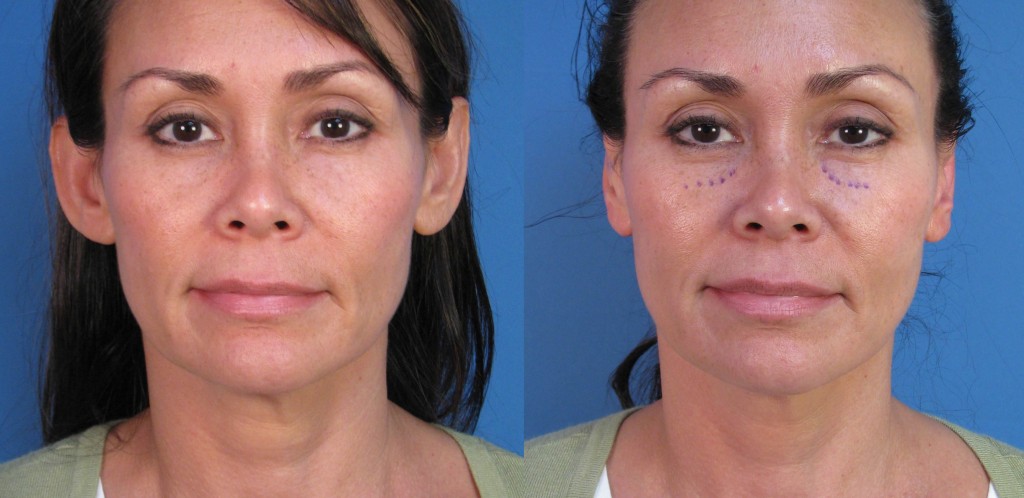
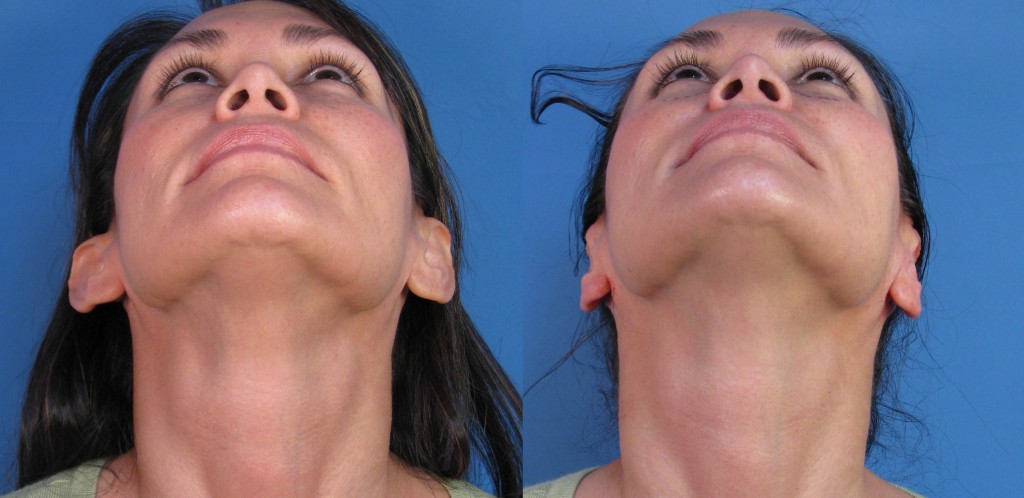
Visibility of Scars
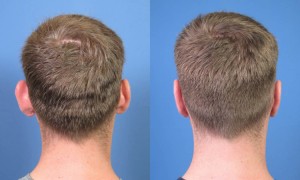
In general, cosmetic otoplasty can usually be entirely from behind the ears so that scarring is kept to a minimum in terms of visibility. The photo example here demonstrates this point visually. As you can see in this male otoplasty patient’s before and after cosmetic ear surgery photos, the scars were made along the backside of the ear, and they are not very visible. After several more months of healing, these scars will become even less visible—to the point of being barely noticeable even when someone is standing directly behind you.
Recovery from Otoplasty
Children usually require one to two weeks off of school for recovery. Adults undergoing this procedure can usually return to work within a few days. You will be prescribed pain medication to keep you comfortable for the first five to seven days. In addition, you will be given a prescription for an oral antibiotic to take for about one week following the otoplasty. Stitches are removed within five to seven days.
A somewhat bulky compression wrap is placed around the head after surgery to hold the ears in position and minimize chances of hematoma formation (unwanted blood clots under the skin). This wrap is usually removed within one to two days at the follow-up and replaced with a more comfortable compression wrap that can be taken on and off by the patient.
You will be recommended to wear your compression wrap around your ears continuously for about one week. Thereafter, you can typically go without the wrap during the day, but it is recommended that you replace the wrap during the evening and while sleeping at night. You should wear the wrap overnight for up to six to eight weeks following the otoplasty. This helps ensure that your ears remain stable and in the desired position during the first couple of months of healing.
Aerobic activity and reconditioning can be resumed within 10 to 14 days while more strenuous activity and resistance workouts may be resumed within three to four weeks. The benefits of this operation with minimal down time makes it a very rewarding and satisfying surgery.
Click on the video below to watch an otoplasty patient testimonial just minutes after her surgery:
Otoplasty Results
Anyone considering otoplasty, or ear reshaping, should be aware of the fact that your ears will look overcorrected during the first few weeks following the surgery. This is done intentionally to account for relaxation of the ear cartilage that will inevitably take place during the first few months. If overcorrection of the ears is not done at the time of the otoplasty, you will risk losing much of the improvement that is seen early on. So what does this mean visually? In the first few days to weeks following otoplasty, the ears look as if they are somewhat stuck to the side of the head. There is barely any angulation of the auricle off of the head and the normal anatomical landmarks on the surface of the ear are barely visible. Don’t let this alarm you. This is what the ears are expected to look like in the early postoperative period. As the days and weeks go on, the ears will begin to assume their desired shape and the surface contours will start to look more normal.
A realistic goal in otoplasty is to achieve an improvement in the size and shape of the ears such that there is little obvious difference between the two sides. Unfortunately, there will always be some degree of asymmetry between the ears, even after a well-performed otoplasty procedure. Expecting perfection following otoplasty (and any other type of cosmetic procedure) is simply unrealistic. Other potential, though quite rare, risks of otoplasty include infection, bleeding, and abnormal scarring (such as hypertrophic and keloid scar).3
Keep in mind that in some cases, a minor touch-up procedure may be necessary to account for unwanted and uncontrollable scar tissue formation and cartilage relaxation. Fortunately, this is not the rule of thumb following otoplasty. In most cases, the ears heal without consequence. In those that might need a touch-up procedure, it is usually performed after waiting four to six months and is typically much less involved than the original otoplasty.
Case Study
Schedule A Consultation For Otoplasty
Do you have additional questions about otoplasty? View our frequently asked questions below to learn more about the procedure. To schedule your consultation, please contact our San Diego office today.
Otoplasty FAQs
What is otoplasty?
Otoplasty, also referred to as ear reshaping or ear pinning, is a plastic surgery procedure designed to improve the appearance of an abnormally shaped ear, such as a lop ear or cup ear. This commonly involves making the ears smaller and/or less prominent
Who is a good candidate for otoplasty?
Good candidates for otoplasty include healthy individuals who desire reshaping of one or both ears. Otoplasty may be performed as early as age four. There are three common abnormalities that are seen in otoplasty candidates. The first involves an external ear (known as the auricle) that is larger and/or more prominent than normal. Most candidates for otoplasty have ears that are angled or protrude excessively from the head. The normal angle between the head (level of the scalp) and the ear is approximately 30 degrees, which corresponds to a distance of approximately 15 mm measured directly from the head (level of the scalp) to the rim of the ear (known as the helical rim). Patients with ears that demonstrate more angulation than 30 degrees and/or have a helical rim greater than 15 mm from the head are considered good candidates for otoplasty. These patients have ears that are not only prominent from the frontal view but also appear to stick out directly from the side of the head on lateral view (see diagram). A significant component of the excessively prominent ear is a conchal bowl that is too large. The conchal bowl is the concave center of the external ear that plays a key role in how the ear is positioned.
The second abnormality commonly seen in patients is an ear that appears flattened across the upper half. A normal ear should have a well defined fold, or ridge, across the upper half, termed the antihelix (see diagram). It is when this natural fold is absent, such as in patients without a well formed antihelix, that the ear draws unwanted attention. This lack of antihelix folding also contributes to an ear that protrudes excessively. The third common abnormality seen in otoplasty candidates is a lobule (the floppy lower rim of the ear where earrings are usually placed) that protrudes excessively from the head. This is sometimes a separate deformity from the prominent helical rim and requires distinct attention.
Are there any age restrictions for undergoing otoplasty?
Otoplasty may be performed on adults and on children four years of age or older. It is often recommended to parents that children undergo otoplasty between the ages of four to six as this can help to alleviate the potential psychological stress that can result from classmate comments and criticism. In reality, many children do not undergo the procedure and, as a result, many teenagers and adults are still considered good candidates for otoplasty. Many young adult female patients seek otoplasty because they are experiencing increasing difficulty with constantly wearing their hair down to conceal excessively large or prominent ears.
Where is the otoplasty procedure performed?
Our facial plastic surgeon, Dr. John Hilinski, usually performs otoplasty in an outpatient surgery center.
What type of anesthesia is used for otoplasty?
Children undergoing otoplasty typically require general anesthesia whereas local anesthesia and oral sedation may be used for adults and young adults.
How is the otoplasty surgery performed?
The otoplasty surgery begins by carefully marking the front of the ear to indicate the planned changes. The back of the ear is also marked to indicate exactly how much of the excess skin will be removed. A barbell-shaped incision is then made on the back surface of the ear and the excess skin removed. In cases where the conchal bowl is excessively large, it is reduced in size by first weakening the cartilage then suturing the bowl closer to the head with several permanent stitches. In essence, this pins the ear back to a more normal position. In cases where the antihelix is poorly formed, several Mustarde sutures are placed to create a normal appearing ridge, or fold. These sutures are carefully placed permanent stitches that help to fold the flat cartilage upon itself, thereby forming an antihelix. These combined maneuvers are usually sufficient to bring the helical rim to within 15 mm of the surface of the head with an angle of less than 30 degrees. If the lobule is excessively angled away from the head, it requires repositioning/reshaping as well to achieve an overall balance with the remaining ear. The lobule is usually reshaped using permanent sutures placed behind the ear. Once the desired changes are made, the incision behind the ear is then closed in layers and a compressive pressure wrap is applied to help hold the ears in position as the healing process begins.
Where are the incisions made for otoplasty?
The incisions for otoplasty are not considered visible as they are hidden behind the ear near the natural crease where the ear attaches to the head.
Are there scars after otoplasty?
While the incisions for otoplasty do result in scars, they are not visible as they are hidden behind the ear near the natural crease where the ear attaches to the head.
Is otoplasty a painful procedure?
Any pain or discomfort that patients experience after otoplasty is generally very tolerable and can easily be controlled with low-dose medication.
What is the recovery like after otoplasty?
Patients can expect an initial recovery of about five to seven days. After this time, the stitches and bandages will be removed, though patients will be instructed to wear a lighter headband at night for the next three to four weeks. Once the bandages are removed, patients should expect to see a slight overcorrection in terms of the amount of setback. This is normal and the ears will begin to settle and rebound somewhat during the next few weeks. Pain is usually very tolerable and easily controlled with low-dose medication. Patients may return to work or school within five to seven days, or sooner if they are not bothered by the bandages. Aerobic activity and reconditioning will need to be postponed for ten to fourteen days after surgery, and strenuous activity and resistance workouts for three to four weeks.
When will I be able to return to work after undergoing otoplasty?
Patients are usually able to return to work or school within five to seven days after surgery. Patients who are not bothered by the bandages may be able to return to work sooner.
When will I be able to exercise after my otoplasty procedure?
Aerobic activity and reconditioning may be resumed within ten to fourteen days after surgery. More strenuous activity and resistance workouts may be resumed after three to four weeks.
When are the stitches removed after the otoplasty procedure?
The stitches are usually removed within five to seven days after otoplasty.
Are there risks or complications with otoplasty?
As with all types of surgery, there are potential risks associated with otoplasty. In general, the risk of infection and bleeding are very low. There is a very small risk that the body will not accept the permanent sutures, though this rarely occurs. There is also the risk of the ears appearing asymmetric after surgery, though patients should be aware that everyone has some degree of asymmetry naturally. The goal of otoplasty is to achieve a similar shape and size between the ears to within 1-3 mm, and amount of difference that is typically imperceptible and not visible to the naked eye.
Does insurance cover otoplasty?
Otoplasty is rarely covered by insurance.
References
1 Ronen Nazarian and Adrien A. Eshraghi. Otoplasty for the Protruded Ear. Semin Plast Surg. 2011 Nov; 25(4): 288–294. doi: 10.1055/s-0031-1288921
2 Mayo Clinic. Otoplasty. Available: https://www.mayoclinic.org/tests-procedures/otoplasty/about/pac-20394822
3 ASPS. Ear Surgery. Available: https://www.plasticsurgery.org/cosmetic-procedures/ear-surgery/safety. Accessed February 28, 2023.
Dr. John Hilinski has either authored or reviewed and approved this content.



